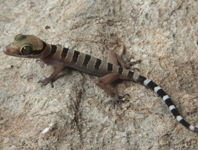Abstract
A new species of Acropomatid fish, Verilus costai sp. nov., is described from a single locality off Belmonte, State of Bahia, Brazil. It resembles Verilus pseudomicrolepis (Schultz, 1940) from the Caribbean Sea. The two are considered vicariant and they are interpreted to be separated from other species of the genus Verilus by (amongst other characters) the presence of fangs on the dentary (vs. only villiform teeth), the anal fin formula (II+9 vs. III+7) and the naked occiput (vs. scaled). However, formal establishment of a separate genus is postponed until a complete phylogenetic review of the family has been performed. Verilus costai can be distinguished from V. pseudomicrolepis by its higher number of gill rakers (27–31 vs. 21–25), lower number of pseudobranchial filaments (15–23 vs. 21–28), shorter snout length (8.2–11.3 vs. 11.3–13.4 % of SL), and more compressed otoliths (OL:OH = 1.3–1.35 vs. 1.35–1.5). In addition, the fossil otolith-based species Verilus mutinensis (Bassoli, 1906) from the late Miocene to middle Pleistocene of the Mediterranean is thought to be related and indicates that in the past this group was more widely distributed than nowadays and comprised more vicariant species.
References
Agiadi, K., Koskeridou, E., Triantaphyllou, M., Girone, A. & Karakitsios, V. (2013) Fish otoliths from the Pliocene Heraklion Basin (Crete Island, Eastern Mediterranean). Geobios, 46, 461–472.
https://doi.org/10.1016/j.geobios.2013.07.004
Agiadi, K., Girone, A., Koskeridou, E., Moissette, P., Cornée, J.-J. & Quillévéré, F. (2018) Pleistocene marine fish invasions and paleoenvironmental reconstructions in the eastern Mediterranean. Quaternary Science Reviews, 196, 80–99.
https://doi.org/10.1016/j.quascirev.2018.07.037
Costa, P.A.S., Braga, A.C., Melo, M.R.S., Nunan, G.W.A., Martins, A.S. & Olavo, G. (2007) Assembleìias de teleoìsteos demersais no talude da costa central brasileira. In: Costa, P.A.S., Olavo, G. & Martins, A.S. (Eds.), Biodiversidade da fauna marinha profunda na costa central brasileira. Série Livros 24. Museu Nacional, Rio de Janeiro, pp. 87–107.
Ghedotti, M.J., Gruber, J.N., Barton, R.W., Davis, M.P. & Smith, W.L. (2018) Morphology and evolution of bioluminescent organs in the glowbellies (Percomorpha: Acropomatidae) with comments on the taxonomy and phylogeny of Acropomatiformes. Journal of Morphology, 279 (11), 1640–1653.
https://doi.org/10.1002/jmor.20894
Girone, A., Nolf, D. & Cappetta, H. (2006) Pleistocene fish otoliths from the Mediterranean Basin: a synthesis. Geobios, 39, 651–671.
https://doi.org/10.1016/j.geobios.2005.05.004
Hubbs, C.L. & Lagler, K.F. (1947) Fishes of the Great Lakes region. Cranbook Institute of Sciences Bulletin, 26, 1–186.
Mejía, L.S., Acero-P., A., Roa, A. & Saavedra, L. (2001) Review of the Fishes of the genus Synagrops from the Tropical Western Atlantic (Perciformes: Acropomatidae). Caribbean Journal of Science, 37 (3–4), 202–209.
Mincarone, M.M., Nielsen, J.G. & Costa, P.A.S. (2008) Deep-sea ophidiiform fishes collected on the Brazilian continental slope, between 11° and 23°S. Zootaxa, 1770 (1), 41–64.
https://doi.org/10.11646/zootaxa.1770.1.2
Mincarone, M.M., Di Dario, F. & Costa, P.A.S. (2014) Deep-sea bigscales, pricklefishes, gibberfishes and whalefishes (Teleostei: Stephanoberycoidei) off Brazil: new records, range extensions for the south-western Atlantic Ocean and remarks on the taxonomy of Poromitra. Journal of Fish Biology, 85, 1546–1570.
https://doi.org/10.1111/jfb.12515
Nelson, J.S., Grande, T.C. & Wilson, M.V.H. (2016) Fishes of the World. Wiley, New Jersey. 707 pp.
https://doi.org/10.1002/9781119174844
Poey, F. (1860) Memorias sobre la historia natural de la Isla de Cuba, acompañadas de sumarios Latinos y extractos en Francés, La Habana, Tomo 2, pp. 97–336.
https://doi.org/10.5962/bhl.title.2485
Schwarzhans, W.W. (1978) Otolithen aus dem Unter-Pliozän von Süd-Sizilien und aus der Toscana. Berliner Geowissenschaftliche Abhandlungen, Reihe A, 8, 1–52.
Schwarzhans, W.W. (1986) Die Otolithen des Unter-Pliozän von Le Puget, S-Frankreich. Senckenbergeana lethaea, 67, 219–273.
Schwarzhans, W.W. & Prokofiev, A.M. (2017) Reappraisal of Synagrops Günther, 1887 with rehabilitation and revision of Parascombrops Alcock, 1889 including description of seven new species and two new genera (Perciformes: Acropomatidae). Zootaxa, 4260 (1), 1–74.
https://doi.org/10.11646/zootaxa.4260.1.1
Yamanoue, Y. (2016) Revision of the genus Verilus (Perciformes: Acropomatidae) with a description of a new species. Journal of Fish Biology, 89 (5), 2375–2398.
https://doi.org/10.1111/jfb.13124
Yamanoue, Y., Johnson, G.D. & Starnes, W.C. (2009) Redescription of a poorly known acropomatid, Verilus sordidus Poey 1860, and comparison with Neoscombrops atlanticus Mochizuki and Sano 1984 (Teleostei: Perciformes). Ichthyological Research, 56 (4), 400–406.
https://doi.org/10.1007/s10228-009-0131-0
Yamanoue, Y. & Matsuura, K. (2004) A review of the genus Malakichthys Döderlein (Perciformes: Acropomatidae) with the description of a new species. Journal of Fish Biology, 65 (2), 511–529.
https://doi.org/10.1111/j.0022-1112.2004.00469.x

